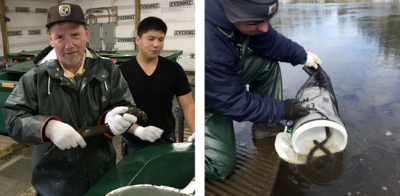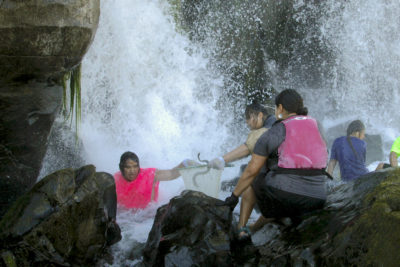“Thousands of sea lamprey are passed upstream [on the Connecticut River] each year. This is a predator that wiped out the Great Lakes lake-trout fishery. [Lampreys] literally suck the life out of their host fish, namely small-scale fish such as trout and salmon. The fish ladders ought to be used to diminish the lamprey.” So editorialized the Lawrence (Massachusetts) Eagle-Tribune on December 15, 2002.
If that’s true, why this spring is Trout Unlimited — the nation’s leading advocate for trout and salmon — assisting the Town of Wilton, Connecticut and an environmental group called “Save the [Long Island] Sound” in a project that will restore 10 miles of sea lamprey spawning habitat on the Norwalk River?
Why this summer will the first big returns from stocked Pacific lampreys — a species similar to sea lampreys — climb specially-designed lamprey ramps at Columbia River dams and surge into historical spawning habitat in Oregon, Washington, and Idaho?
And why, when the canal at Turners Falls on the Connecticut River is drawn down in September, will the Connecticut River Conservancy, Fort River Watershed Association, and the Biocitizen environmental school rescue stranded sea lamprey larvae?
In their native habitat, marine lampreys are keystone species, providing food for everything from insects to eagles.
The answer is ecological awakening — the gradual realization that, if the whole of nature is good, no part can be bad. In their native habitat, marine lampreys are “keystone species” supporting vast aquatic and terrestrial ecosystems. They provide food for insects, crayfish, fish, turtles, minks, otters, vultures, herons, loons, ospreys, eagles, and hundreds of other predators and scavengers. Lamprey larvae, embedded in the stream bed, maintain water quality by filter feeding; and they attract spawning adults from the sea by releasing pheromones. Because adults die after spawning, they infuse sterile headwaters with nutrients from the sea. When marine lampreys build their communal nests, they clear silt from the river bottom, providing spawning habitat for countless native fish, especially trout and salmon.
Environmental consultant Stephen Gephard, formerly Connecticut’s anadromous-fish chief, calls lampreys “environmental engineers” as important to native ecosystems as beavers.
Marine lampreys, our elders by some 340 million years, depend on cold, free-flowing freshwater for spawning. They are boneless, jawless, eel-like fish with fleshy fins. They extract body fluids from other fish via tooth-studded suction disks. Both sea lampreys and Pacific lampreys are widely reviled because they are perceived as “ugly” and because sea lampreys decimated indigenous fish in the upper Great Lakes when they gained access to those waters via human-built canals, most likely the Welland Canal that bypassed Niagara Falls. Once there, they nearly wiped out valuable commercial and sport fisheries for lake trout (the largest char species, not a true trout like rainbows, cutthroats, and browns).
A bald eagle carries a sea lamprey snatched from the Connecticut River in Windsor, Vermont.
Mary Holland / Naturally Curious
By the 1960s, non-native sea lampreys had reduced the annual commercial take of lake trout in the upper Great Lakes from about 15 million pounds to half a million pounds. In 1955, Canada and the United States established the Great Lakes Fisheries Commission, which controls lampreys with barriers, traps, and a remarkably selective larvae poison called TFM. Lamprey control costs $15 to $20 million a year; and without it, ongoing lake-trout recovery would be impossible, and populations of all other sport fish would crash.
But in saltwater, lampreys are in natural balance and deplete nothing. When they run up freshwater streams to spawn they can’t “suck the life out of their host fish” because they go blind and lose their teeth.
The native habitat of sea lampreys extends from Labrador to the Gulf of Mexico and from Norway to the Mediterranean. Native habitat of Pacific lampreys extends from the Aleutians to Baja California and from Siberia to Japan.
Pacific lampreys are highly valued for food, ceremonies, and medicine by tribes in the Pacific Northwest, and these tribes are driving recovery. The U.S. Fish and Wildlife Service now recognizes the Pacific lamprey as a “high conservation risk” in most river basins. The most recent international status assessment lists it as “critically imperiled” in Oregon, Washington, and Idaho. And Mexico lists it as “threatened.”
As recently as the early 2000s, the Maine fisheries department was capturing and killing spawning sea lampreys.
Sea lampreys are a traditional delicacy in Europe. In a fit of royal gluttony, King Henry I of England is said to have died from a “surfeit of lamprey.” In Spain, Portugal, and France, they’re still commercially fished. There’s recovery work, especially in Portugal where the species is listed as “vulnerable.”
But in North America, lampreys have been largely ignored as food. And because of the Great Lakes catastrophe, appreciation for them is an ongoing process. As recently as the early 2000s the Maine Department of Inland Fisheries and Wildlife was capturing and killing spawning sea lampreys. And it opposed dam removal on the Sheepscot River (completed in 2019) because it would let lampreys access historical spawning habitat.
When Fred Kircheis was directing the Maine Atlantic Salmon Commission, he attributed the department’s persecution of lampreys to “uninformed bias” and the fact that “transformers” (newly metamorphosed larvae) left scars the width of a pencil on a few landlocked salmon in Sheepscot Lake. Usually, he explains, transformers are just hitchhiking by merely sucking onto fish. But when low water temporarily blocks access to the sea, they occasionally feed. with scant damage to hosts.
Today the department is completely on board with lamprey recovery. On Maine’s Penobscot River, lamprey runs are exploding now that the biggest river-recovery project in North America has removed two dams and bypassed a third, opening 2,000 additional miles of habitat. Maine researchers report that small fish are growing faster and larger around the communal lamprey nests and that brook trout and salmon are spawning in the wide expanses of gravel lampreys clear of silt.
Left: Douglas Nemeth of the U.S. Fish and Wildlife Service holds a Pacific lamprey at a Nez Perce facility in Idaho. Right: Nez Perce biologist Tod Sween releases lampreys into a Columbia River tributary.
U.S. Fish and Wildlife Service
The global leader in both sea-lamprey recovery and education is Connecticut. Not only is it removing dams and impassable culverts, it’s the only state restoring extinct sea-lamprey runs by translocating larvae and pre-spawn adults. Sea lampreys don’t home to natal rivers like salmon, so when Connecticut transfers lampreys to former habitat, the entire Atlantic Coast benefits.
“Connecticut was the first state to publicly contradict the commonly held belief about sea lamprey and took every opportunity to educate the public and promote restoration,” says Gephard. “No erroneous statements or misrepresentations were left unchallenged. The opposition to sea lamprey disappeared quickly in Connecticut, followed by the other Connecticut River states and finally most of New England.”
Writing in the May 2022 Estuary Magazine, Gephard and his colleague, fisheries consultant Sally Harold, reported what they observed while snorkeling downstream of a communal lamprey nest: “An entire school of spottail shiners is lingering, intimidated by our presence and gobbling any errant eggs that are swept past the gravel mound. Dozens of common shiners, the males displaying vivid flashes of orange on their fins, are darting in and out of the nest, snatching the tiny eggs before they sink to the bottom. Even when an egg falls amongst the gravel, it may not be safe. As we watch, the heads of small American eels — elvers — protrude from the gravel in search of eggs. A typical lamprey female will produce around 200,000 eggs, so there are enough to share.”
“In California, we displayed a Pacific lamprey, and a kid from Hoopa tribe said, ‘That looks delicious.’”
In the Connecticut River’s main stem, Gephard sees the carcasses of spawned-out lampreys seething with feeding caddisfly larvae, prime forage for birds and dozens of fish species.
Sean Ledwin, director of Maine’s Bureau of Sea Run Fish and Habitat, used to work on Pacific lampreys. To illustrate the difference in western and eastern perceptions he tells the story of his outreach efforts. “In Maine,” he says, “people are horrified when we show them sea lampreys. In California we displayed a Pacific lamprey in a tank, and a kid from Hoopa tribe said, ‘That looks delicious.’”
But outside the tribes, education remains a challenge. “The general perception is that lampreys are ugly, gross, and dangerous,” remarks Christina Wang of the U.S. Fish and Wildlife Service’s Columbia River Fish and Wildlife Conservation Office. “Newspapers keep running headlines like ‘Blood-Sucking Vampire Fish. Save Them or Kill Them?’ People, especially transplants from the Midwest, get creeped out by lampreys. I’ve been a lamprey biologist for 20 years. When I started the only people who cared about lampreys were the tribes. Now we’re getting through to more people. We have an exhibit at the Oregon Zoo. The general person comes up and says, ‘Oh, are you trying to get rid of them? Are they going to attach to our legs?’ But then we tell them the facts, and they change their minds.”
Members of Pacific Northwest tribal nations catch lampreys at Williamette Falls in Oregon.
Gosia Wozniacka / AP Photo
Unlike sea lampreys, Pacific lampreys can climb sheer waterfalls, sucking on and resting as they go. But they have trouble with the rough, sharp edges of traditional fish ladders. So the U.S. Army Corps of Engineers, a partner in the multi-entity Pacific Lamprey Conservation Initiative, has designed near-vertical, aluminum lamprey ramps with resting pools that allow a large percentage of lampreys to make it over Columbia River dams.
In the river, Pacific lampreys face swarms of non-native predators like smallmouth bass, striped bass and walleyes, as well as an unnatural superabundance of native predators created by the impoundments and by the lampreys and other sea-run fish massed against the dams. These predators include sturgeon, sea lions, seals, gulls, terns, cormorants, and northern pikeminnows. The Pacific States Marine Fisheries Commission even pays a bounty on pikeminnows.
Predators, habitat destruction, global warming, and past persecution of lampreys — including by managers using the fish-poison rotenone — have reduced Pacific lampreys to the point that the only place the tribes can now legally catch them is Willamette Falls on the Willamette River.
But the tribes are fighting back. The Nez Perce in Idaho, the Yakama in Washington, and Umatilla in Oregon are transferring pre-spawn adults, collected in traps at the three lower Columbia River dams, to depleted habitat upstream. And the Yakama and Umatilla raise Pacific lampreys in hatcheries for stocking.
“I’m sorry if native lampreys creep people out,” says one fisheries biologist. “But everyone’s got to make a living.”
Pacific lampreys also differ from sea lampreys in that adults can spend a year or two in the river before spawning. This makes transplantation easier. The Yakama transfer the most but keep a few to maintain hatchery stock.
It’s working. “Larvae take three to nine years to transform, so we’re just starting to get adults from the ocean from the juveniles we’ve stocked,” says Ralph Lampman, biologist for the Yakama Lamprey Project. “We got 20 adults back in 2020 but more than 500 in 2022.” This year he’s expecting lots more. The 2023 run will peak in July.
On both coasts, the greatest education challenge is in Vermont, because the state is killing lampreys with one hand and restoring them with the other. In Lake Champlain Vermont is engaged in intense lamprey poisoning with TFM. This is necessary because even if lampreys are native to Champlain, without control they would annihilate the hatchery-bred strains of salmon and lake trout that didn’t co-evolve with them and that have replaced the native strains extirpated long ago by dams, pollution, and overfishing.
But in the Connecticut River system, Vermont is engaged in equally intense lamprey recovery, determining traditional spawning habitat and opening known habitat by removing dams and impassable culverts.
Vermont fisheries biologist Lael Will keeps getting reports of people “freaking” when they see lampreys in Connecticut River tributaries, then grabbing them and throwing them onto the bank. She gives presentations explaining that, in freshwater, native lampreys help aquatic and terrestrial wildlife and that they can’t attach to humans or fish. And she publishes press releases urging the public to leave native lampreys alone. Her message, she reports, is “starting to catch on.”
“I’m sorry if native lampreys creep people out,” declares Will, “but everyone’s got to make a living. These guys are just making a living in a different way.”



